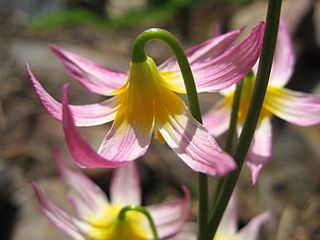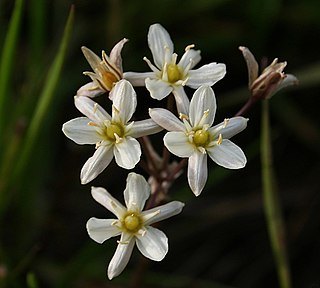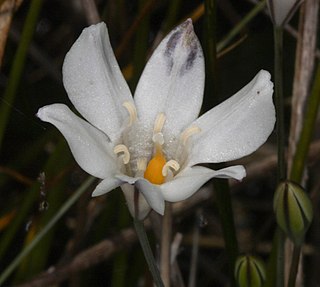
Triteleia is a genus of monocotyledon flowering plants also known as triplet lilies. The 16 species are native to western North America, from British Columbia south to California and east to Wyoming and Arizona, with one species in northwestern Mexico. However they are most common in California. They are perennial plants growing from a fibrous corm, roughly spherical in shape. They get their name from the fact that all parts of their flowers come in threes.

Eugenia haematocarpa is a rare species of plant in the family Myrtaceae. It is endemic to Puerto Rico. It is classified as an endangered species by the U.S. Fish and Wildlife Service and there has been a plan for its recovery in place for some years. Its common names include uvillo and Luquillo Mountain stopper.

Allium shevockii is a rare species of wild onion known by the common name Spanish Needle onion. It is found only in a limited area in the southern Sierra Nevada of California.

Triteleia lugens, the Coast Range triteleia or dark-mouthed triteleia, is a monocot flowering plant in the genus Triteleia. It is endemic to California, where it is known from the Coast Ranges north and south of the San Francisco Bay Area. Its habitat includes forests and chaparral.

Triteleia ixioides, known as prettyface or golden star, is a monocotyledon flowering plant in the genus Triteleia. It is native to northern and central California and southwestern Oregon, where it can be found in coastal and inland coniferous forests and other habitat. It is a perennial wildflower growing from a corm. It produces one to two basal leaves up to 50 centimeters long by 1.5 wide. The inflorescence arises on an erect stem up to 80 centimeters tall. It is an umbel-like cluster of several flowers each borne on a pedicel up to 7 centimeters long. The flowers are variable in size, measuring one to nearly three centimeters in length. They are pale to bright yellow, or sometimes purple-tinged white. There are six tepals with darker midveins in shades of green, brown, or purple. The lobes are funnel-shaped and may open flat or somewhat reflexed. The six stamens form a fused tube that protrudes from the corolla; they have broad, flat filaments and whitish, yellowish, or blue anthers.

Triteleia lilacina, the foothill triteleia, is a monocot flowering plant in the genus Triteleia.

Triteleia crocea, with the common names yellow triteleia and yellow tripletlily, is a monocot flowering plant in the genus Triteleia.
Downingia montana is a species of flowering plant in the bellflower family known by the common name Sierra calicoflower. This showy wildflower is native to California, where it lives in the meadows and pine forests of the high mountains. Its range may extend into Oregon. This annual grows an erect stem, which may branch or not, with a few sparse small, pointed leaves. Atop the stem is usually one tubular flower. The upper lip is made up of two narrow, pointed lobes usually a shade of lavender, and the lower lip is the same color, with a central field of white and two prominent projections which may be colored yellow and dark purple. The lower lip has three lobes, each of which may have a tooth. The fruit is a capsule one to four centimeters long.

Erythronium purpurascens is a species of flowering plant in the lily family which is known by the common names purple fawn lily and Sierra Nevada fawn lily.

Gentianopsis holopetala is a species of flowering plant in the gentian family known by the common names Sierra fringed gentian or just "Sierra gentian"'. It is native to the Sierra Nevada and adjacent mountains in California and Nevada, in wet meadows from 6000 to 11,000 ft in elevation. This is an annual or perennial herb, growing stems which may be anywhere from a few centimeters long to nearly half a meter, and may lay along the ground or grow erect. Its small oval or spoon-shaped leaves are mostly basal but may grow sparsely further along the stem.

Hulsea algida is a species of flowering plant in the daisy family, known by the common name Pacific hulsea or alpine gold.

Leptosiphon nuttallii is a species of flowering plant in the phlox family known by the common name Nuttall's linanthus.
Lupinus grayi is a species of lupine known by the common name Sierra lupine. It is endemic to California, where its distribution extends the length of the Sierra Nevada and its foothills and includes the Tehachapi Mountains.

Muilla maritima is a species of flowering plant known by the common names sea muilla and common muilla. It is native to California and Baja California, where it grows in many types of habitats from the coast to the Mojave Desert and Sierra Nevada foothills and other inland mountains, in grassland, woodland, desert, and forest floras. It is a perennial plant growing from a corm and producing an erect flowering stem up to half a meter tall. The onion-like leaves at the base of the stem may be 60 centimeters long. The flowering stem bears an umbel-shaped array of many flowers on pedicels up to 5 centimeters long. Each flower has six tepals which are green-tinged white in color with brownish midribs and no more than 6 millimeters in length. At the center of the flower are six erect stamens with blue, green, or purplish anthers.

Odontostomum is a monotypic genus of flowering plants containing the single species Odontostomum hartwegii, which is known by the common name Hartweg's doll's-lily. In the APG III classification system, it is placed in the family Tecophilaeaceae. It was formerly placed in the Liliaceae. It This wildflower is endemic to northern California, where it can be found in the inner coastal mountain ranges and the Sierra Nevada foothills. It grows in rocky clay and often serpentine soils in grassland and woodland habitat, sometimes near vernal pools. This is a perennial herb growing from an oval-shaped corm up to 3 centimeters wide deep in the soil. The curving, widely branching stem is up to about half a meter in maximum height with linear leaves up to 30 centimeters long sheathing the lower portion. The inflorescence is a raceme or panicle of several flowers on pedicels. Each flower has six white or yellowish tepals, the lower parts fused into a veined tube and the tips spreading and then becoming reflexed. At the center of the flower are six stamens and six staminodes in a ring around the gynoecium.

Triteleia clementina is a rare species of flowering plant known by the common name San Clemente Island triteleia. It is endemic to San Clemente Island, one of the Channel Islands of California, where it is known from about twenty occurrences. Its habitat includes moist, rocky, seaside grassland. It is a perennial herb growing from a corm. It produces two or three keeled, lance-shaped leaves up to 100 centimeters long by three wide. The inflorescence arises on an erect stem up to 90 centimeters tall and bears an umbel-like cluster of many flowers. Each flower is a funnel-shaped lavender or light blue bloom with six lobes measuring up to 1.5 centimeters long. There are six stamens with purple anthers.
Triteleia dudleyi is a species of flowering plant known by the common name Dudley's triteleia. It is endemic to California, where it is known from sections of the High Sierra Nevada and the Transverse Ranges. It is a plant of subalpine climates, growing in mountain forests. It is a perennial herb growing from a corm. It produces two or three basal leaves up to 30 centimeters long by one wide. The inflorescence arises on an erect stem up to 30 or 35 centimeters tall and bears an umbel-like cluster of many flowers. Each flower is a funnel-shaped yellow bloom that dries purple. The flower has six lobes measuring up to 1.2 centimeters long. There are six stamens with lavender anthers.

Triteleia grandiflora is a species of flowering plant known by the common names largeflower triteleia, largeflower tripletlily and wild hyacinth. It is native to western North America from British Columbia to extreme northern California, eastward into Idaho, Montana and northern Utah, with disjunct populations occurring in Wyoming and Colorado. Its habitat includes grassland, sagebrush, woodlands, and forests. It is a perennial herb growing from a corm. It produces two or three basal leaves up to 70 centimeters long by one wide. The inflorescence arises on a smooth, erect stem up to 75 centimeters tall and bears an umbel-like cluster of many flowers. Each flower is a funnel-shaped bloom borne on a pedicel up to 4 or 5 centimeters long. The flower may be up to 3.5 centimeters long including the tubular throat and six tepals each just over a centimeter long. The inner set of three tepals are somewhat ruffled and broader than the outer tepals. The flower corolla may be deep blue to almost white with a darker blue mid-vein. There are six stamens with purple or yellow anthers.

Triteleia hyacinthina is a species of flowering plant known by the common names white brodiaea, white tripletlily, hyacinth brodiaea, and fool's onion. It is native to western North America from British Columbia to Idaho to central California. Its habitat includes grassland and vernally moist areas such as meadows and vernal pools. It is a perennial herb growing from a corm. It produces two or three basal leaves up to 40 centimeters (16 in) long by 2 centimeters (0.79 in) wide. The inflorescence arises on an erect stem up to 60 centimeters (24 in) tall and bears an umbel-like cluster of many flowers. Each flower is a funnel-shaped bloom borne on a pedicel up to 5 centimeters (2.0 in) long. The flower is white, often tinged purple along the tubular throat, with six green-veined tepals. There are six stamens with white, yellow, or occasionally blue anthers.

Triteleia peduncularis is a monocot flowering plant in the genus Triteleia. Its common names include long-ray brodiaea and longray triteleia. It is endemic to California, where it occurs in the coastal and inland mountain ranges of the northern and central sections of the state. It grows in vernally moist habitat such as meadows, grassland, and vernal pools, often in areas with serpentine soils. It is a perennial wildflower growing from a corm. There are two or three basal leaves measuring up to 40 cm (16 in) long and 1.5 cm (0.6 in) wide. The inflorescence arises on a smooth, erect stem up to 80 cm (31 in) tall. It is an umbel-like cluster of several flowers which are borne on very long, straight pedicels measuring up to 18 cm (7.1 in) long. Each funnel-shaped flower is white, often tinged purple, with six tepals up to 1.6 cm (0.6 in) in length. There are six stamens with white anthers, and the ovary at the center is yellow when the flower is fresh.

















